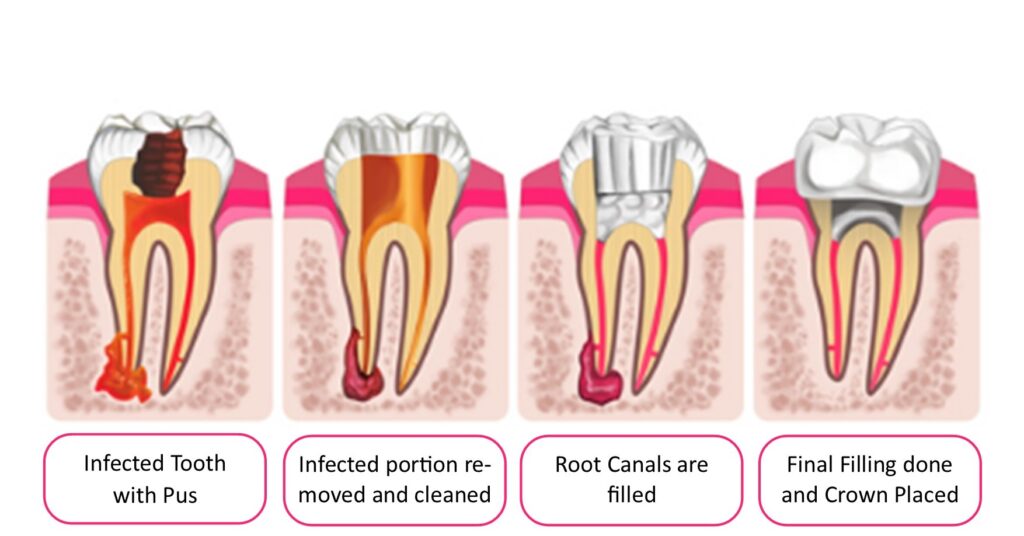
What is Root Canal Treatment (RCT)?
A root canal is a dental treatment used to save a tooth by removing a damaged or inflamed nerve contained in the pulp.
Root canal treatment is an important method used by dentists to save teeth and to avoid unnecessary extractions
Process: –
Root Canal Treatment becomes necessary for a tooth when the tooth pulp becomes infected or inflamed. Usually, a tooth cavity through the enamel and then the tooth dentin area, go towards the tooth pulp
Root Canal Treatment may take only one session with your dentist, or it may take multiple sessions – depending on the tooth. Generally, a molar or large back tooth will take longer since it has more roots, or work for the dentist to do. Though, this may take one session or 2 or 3 sessions – depending on the circumstance.
The root canal treatment entails cleaning the tooth nerve in the root area of the tooth inside the tooth or pulp chamber of the nerve of the tooth, via the inside chamber of the tooth.
Then a filling is placed inside of the canal. The filling is the most commonly practiced way of doing the root canal. The process involves the filling of a material known as gutta-percha, which protects the teeth from any infection and contamination. After filling, a crown that resembles one of the real teeth is placed on gutta-percha to secure the filling.
Aesthetics are another important consideration for root canal patients. Teeth that have become infected may turn yellow, brown, or even black as a result of bacterial build-up in the pulp of the tooth.
The final result of a root canal is a crown that not only looks like a natural tooth but also functions like a natural tooth as well.
RCT over Tooth Extraction
If you lose a tooth, you may have a gap in your smile or you may have trouble eating or even speaking clearly. Tooth loss usually means that patients must undergo some kind of prosthetic intervention with bridgework or crowns or even dental implants in some cases
The root canal relieves pressure from inflammation in the pulp of the tooth may seem, in some cases, like tooth extraction would be the most affordable choice, but in reality, tooth extraction requires more follow-up appointments than root canal treatment and often, patients have to get a denture, bridge, or implant, which drives the cost higher as well as the time commitment for treatment. Further, many dental insurance plans cover root canal treatments. So, affordability and ease of treatment are some of the benefits of getting a root canal as opposed to tooth extraction.
Oral hygiene after a root canal
Continuing to practice good oral hygiene after a root canal is critically important. Brush twice daily, floss once a day, and use antiseptic mouthwash regularly to maintain the health of your teeth.
After RCT
Once your root canal and any other procedures are completed, you’ll have a follow-up visit with your dentist to make sure that everything has healed as it should
Prevention
Things to do to prevent root canal necessity:
1. A regular dental exam at your local dental office. Your dentist will perform a cavity check on teeth, using a probe in the central fossa areas of teeth or various areas, to check for cavities.
2. Regular dental x-rays. Small caries can sometimes be noticeable on dental x-rays.
3. Doing small fillings before they enlarge and become large cavities, exposing the root canal or tooth pulp area.
4. Being careful in contact sports. Teeth that are traumatized or for instance fall on, can become non-vital and may need root canal treatment over time.
